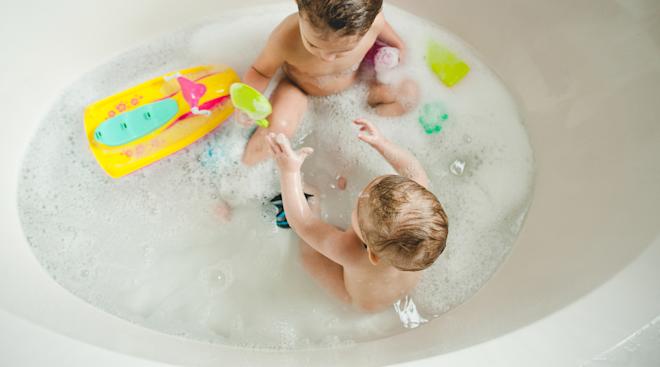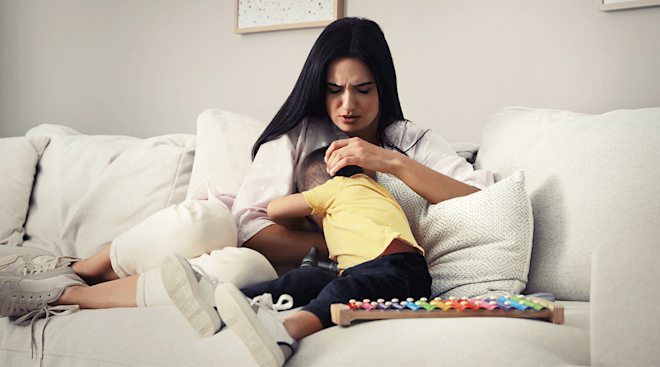10 Gender Stereotype Messages Parents Are Inadvertently Sending Kids
You child might love princesses or PAW Patrol with the power of a thousand suns, but it pales in comparison to the love and admiration they have for you. While it may not seem like your toddler cares much about your opinions as they defiantly toss Cheerios on the floor, the truth is, you’re their guiding star—especially when it comes to how they view gender roles and identities.
Avoiding learned gender stereotypes can be tricky. Even adults can have trouble spotting seemingly innocent behaviors that actually undermine gender equality. But now is the time to be thoughtful about how you portray gender to your young kids. “Between the ages of 3 and 6, your kids are really attuned to gender differences,” says Christia Spears Brown, PhD, director of the Center for Equality and Social Justice at University of Kentucky and author of Parenting Beyond Pink & Blue: How to Raise Your Kids Free of Gender Stereotypes. “It’s important to help them see that not all girls are the same and that some boys are like this or like that.”
And the research backs this up. Children whose parents held egalitarian beliefs were less likely to demonstrate gender stereotypes not just in relation to their own gender, but toward kids of the opposite sex, according to one study.
So what are the common messages about gender that parents are sending—even unconsciously—to kids, and how can you change the narrative? Here’s what the experts say.
Most American parents say sharing household duties is key to a good marriage—but when it comes down to it, 41 percent of mothers say they wind up doing more chores than their husbands, according to data from the Pew Research Center. And that discrepancy trickles down to the kids. According to a study in the Journal of Research on Women and Gender, by the time they’re 8 years old, 58 percent of girls participate in household chores—but only 37 percent of boys are joining in, suggesting that gender differences in home duties begin very early in life.
What’s more disturbing, a survey by BusyKid, an allowance tracking app, showed that boys make twice as much as girls in average weekly allowance money, raking in $13.80 per week compared to $6.71 for girls. Not only are boys getting paid more for the chores they complete, but boys are also being given more money-making opportunities.
The Fix
Given that in 2020 women earn 81 cents to every dollar earned by men, according to a PayScale report, we’re not doing our daughters any favors when we dole out house duties and allowance unequally. After all, chores are rehearsal for real life family dynamics in the future—which means how responsibilities are divided between Mom and Dad matter. “My husband and I treat each other as equals,” says Drew W., a mom of three. “We both cook, clean, discipline and do bath time, laundry and yard work. None of, or at least very few of, the jobs are exclusively mine or his. We also try to maintain the same expectations and rules for all of our kids, regardless of birth order or gender. We want them to become self-sufficient adults, and part of that means instilling confidence that they’re capable people. I want each of them to know how to mow the lawn, change the tube on a bike tire, cook (at least basic) meals and do their own laundry.”
Research backs Drew’s approach: When parents divide household labor equally, children think more flexibly about gender roles. To get everyone on the same page, set up a family meeting when you do the chore chart. Instead of randomly assigning tasks, ask each family member to volunteer for different jobs. “Ask your child to articulate why they’re doing that,” Brown suggests—and watch out for banal replies like “I’ll mow the lawn because Dad does it” or “I’ll make breakfast because Mom always cooks.” Probe for a genuine reason, like tying your child’s love for nature to yard work or a culinary interest to kitchen chores.
And for Pete’s sake, if you pay your kids a chore allowance, make sure it’s equal. There’s no reason your son should earn more than your daughter—you’re all in this together.
The classic “boys don’t cry” stereotype unfortunately still persists. Dads set an important example here. If men display a kaleidoscope of positive emotions in front of their kids but express any negative emotions—like sadness, confusion and anxiety—only through a show of anger, it signals to young ones that opening up about vulnerable feelings isn’t “masculine.” The way parents talk to their young sons about emotions is also key. “Parents of sons don’t ask about feelings because they seem fine,” Brown says. “We check out.” One study found that when talking to their 4-year-old children, moms used more emotion words than dads—but moms of girls tended to use more emotion words than moms of boys.
The Fix
Regardless of whether they have sons or daughters, fathers should strive to share their feelings and expose some level of vulnerability for their kids to see—and get their children to talk about their own feelings too. Instead of asking the prosaic “how was school?” dads can inquire why school was boring or share their own story of feeling left out.
If you do have a son, both parents should check in with him about his feelings, Brown emphasizes. If he’s crying or angry, try to get him to articulate where it’s coming from. “Tears come out of frustration, especially when kids are young,” she adds. “Helping them have a language for it is a helpful skill.” The last thing you want to say or imply is that boys don’t cry. Your goal is to teach your son to process his feelings, whether it’s over something seemingly insignificant, like dropping an ice cream, or something more delicate, like being excluded from a game. It’s not about washing down his sadness, Brown says, but about identifying an emotion and finding a solution.
As a mom, have you ever caught yourself telling your kid, “I’m sorry, but you have to go to time out,” or, “I’m sorry, but you can’t have this anymore” after they threw a toy at their sibling? Why are you the one apologizing for their naughty behavior? But the preemptive “I’m sorry” has become a habit for more than one mom, and it’s not just a parent thing. Women generally tend to apologize more frequently than men, often because they feel they’ve offended someone, according to one study.
It turns out, the superfluous “I’m sorry” is a loaded statement rooted to the archaic idea that women shouldn’t take up space. “It implies, ‘I don’t have the right to say or do whatever,’” says Taryn Myers, PhD, an associate professor of psychology at Virginia Wesleyan University, Virginia Beach. “This is really ingrained in women. They doubt themselves in some way because they’ve gotten cut down in the past or see repercussions for other women speaking out.”
The Fix
Save your apologies for important things, such as, “I’m sorry you I was late picking you up.” The key is to monitor those filler apologies that slip in automatically. “It’s a hard habit to break,” says Myers, who suggests using a counter app for a week to keep a running tally. “Once you’re aware that you are saying ‘I’m sorry’ so frequently, you’ll start to catch yourself. Recognition is the first step toward changing your behavior.”
On top of that, encourage your daughters to embrace activities where they’re a part of the whole, like on sports teams and playgrounds. “One thing I’ve been working with my 4-year-old is telling her that she can take up space too,” says Mandy V., a mom of two. “The other day at the park, a boy cut in line for the zip line and she stood back and looked at me with tears in her eyes. I told her she had every right to be there and encouraged her to tell him that she’s waiting and there’s a line.” By teaching your children to recognize a sense of belonging, you encourage confidence in everyday behaviors and decisions.
Superheroes, with their bulging muscles and battle scenes, aren’t the only ones reinforcing traditional ideals of male strength. We’ve all seen boys playfully wrestling each other in the grass, as parents watch and roll their eyes, saying, “Boys will be boys.” But when boys deviate from rough-and-tough behaviors, it makes some people uncomfortable. “My 5-year-old son loves toenail polish and hair tinsel, but I see that most people aren’t okay with it and say things like, ‘Whoa! Are your nails painted? I guess do it while you can!’ or ‘“Well, he has a big sister so it’s okay,” says Kat D., a mom of two. “I’ve been asked a few times if I’m worried he’s gay. I replied that I’m not worried about him being anything other than mean. He is what he is already. Nail polish and sparkle in his hair aren’t going to change that one way or the other.”
The Fix
It’s important to remember here that just as all boys shouldn’t be expected to enjoy roughhousing, girls can be just as aggressive as boys. Rather than viewing the behavior along gender lines, focus on children’s personalities and tune into whether the rough and tumble play is constructive or causing a child distress. “Are they enjoying themselves, or are they hurting each other? There are boundaries, which shouldn’t be crossed at the expense of someone else. Encourage them to communicate to each other when they’re crossing the line,” Myers says. “It’s important for kids to learn how to read other people, who might have different boundaries. One friend might love to wrestle and another might not, and that’s okay. Don’t force them to do it. Find a different way to play.”
No parent sets out to sabotage their child’s acumen, and yet boys still get more attention and encouragement than girls when it comes to bolstering math skills—in fact, three times as much, according to the Journal of Language and Social Psychology. Research shows that mothers quantify (as in count out four crayons, for example) less frequently when talking to daughters than sons.
Here’s how the lack of math encouragement for girls adds up: By kindergarten girls are less interested in learning about math; by third grade, boys rank their own math skills higher than girls’ (even if there’s no actual difference) and by high school, most adolescents assume boys are plain smarter when it comes to math. The widely accepted stereotype that boys are innately better at math than girls leads to parents acting on the assumption. Children pick up on this and shape their own behavior around the stereotype.
The Fix
“Parents think girls are just as good at math and science, but they also think boys are more interested [in these subjects],” says Brown, who co-authored the aforementioned study. It’s time to reevaluate which toys, books and family excursions you think your children may like, especially when it comes to STEM (science, technology, engineering and math) subjects. It may feel like you’re going against the grain, but give it a go anyway. Pick up the book Rosie Revere, Engineer, a story of a girl who didn’t give up on her invention, and Mae Among the Stars, which retells a story of real life astronaut Mae Jemison’s dream to go into space. Count out jelly beans as you watch Peg + Cat, a cartoon about a girl and her cat who go through adventures by solving math problems. Tell your daughters about a 24-year-old biochemist who won the Miss Virginia pageant by performing a science experiment during the talent portion, and then let your child create her own chemical reaction with baking soda and vinegar.
One could say the call for boys to play sports is indoctrinated from birth—athletic paraphernalia can be found on everything from onesies and bibs to room decor and more. Before long, balls are more than teething toys and parents start shuttling their kids from Little League to Soccer Shots practices. No one can argue the many benefits that come from playing sports—such as teamwork, physical wellbeing, and perseverance, to name a few—but overemphasizing the importance of playing sports for boys well may shift fun into uber-competitiveness that’s rooted to masculine pride, and further the false assumptions that girls aren’t good at sports. We’ve all heard the negative “run/hit/throw like a girl” comments tossed about by parents and kids alike. Some kids are naturally competitive, but having that gender distinction can make losing to a girl particularly disheartening, says Brown. No wonder a similar lack of sportsmanship still exists in the workplace.
The Fix
When one of their teammates scores a goal, your child will care about the collective win, not about the goal-scorer’s gender—making co-ed sport teams an excellent choice for the preschool crowd. Given that kids start to solidify their ideas (and stereotypes) about gender by age 5, aim to give them a range of both male and female athletic role models early on in childhood. “We watch women’s sports like soccer and tennis with my son,” says Danielle D., a mom of two. “The other day, my husband wanted to watch the Tour de France, but my son wasn’t into it. He asked, ‘Where are the girls?’”
Lauding the skills of women athletes can go a long way. Talent is talent, and kids know it. The fact that school-age boys were wearing Alex Morgan jerseys in support of the US national women’s soccer team speaks volumes. Teaching your kids to be mindful of their competitiveness can also make a difference in attitude. If your son outhits a girl in tennis, explain to him that he won because he practiced, not because girls aren’t good at tennis.
On one hand, some moms love dressing up their little girls in bows and frilly dresses. On the other hand, most moms aren’t exactly always singing, “I feel pretty, oh, so pretty”—more like, “Do I feel pretty? I haven’t washed my hair in three days.” No matter how you look at it, the message that kids are picking up is that appearance is important—especially girls, who look to their moms as role models. “Sons are also learning that women should look a certain way,” adds Brown.
Studies confirm this: After monitoring children’s Disney Princess engagement for a year, researchers found that both boys and girls were more likely to embrace more female gender-stereotypical behavior. “We are a very visually focused culture,” adds Myers. “We judge each other and then tear each other apart.” This, too, is learned behavior.
The Fix
While research shows that women who focus too much on their appearance are less willing to speak up, you don’t need to toss all tulle and sparkles just yet. You can still raise a confident, competent child who values inner beauty and stands up for what’s right. Take solace in author Chimamanda Ngozi Adichie wise words: “Feminism and femininity are not mutually exclusive. It is misogynistic to suggest that they are. Sadly, women have learned to be ashamed and apologetic about pursuits that are seen as traditionally female, such as fashion and makeup. But our society does not expect men to feel ashamed of pursuits considered generally male—sports cars, certain professional sports.”
The key to debunking gender stereotypes is to prevent appearance from becoming a defining factor of one’s character. Dressing up is fun, and discouraging a child from wanting a princess dress would go against the notion of choosing for oneself. (Though highlighting that it’s not just the gown that makes a princess great sends a more positive message.) “Disney has done a good job with the newer princess movies,” says Devorah Blachor, author of The Feminist’s Guide to Raising a Little Princess. “Moana isn’t a love story, and neither is Frozen. These are exactly the kind of characters girls need to see—adventurous and brave, yet human and compassionate.”
Modeling positive appearance and body image is also crucial. “Be mindful of comments about yourself,” says Brown. “These are teaching moments for your kids. Don’t say anything about yourself you don’t want your daughter to say about herself.”
We’ve all been there: Your husband is lost but refuses to ask for directions. You even volunteer to ask for him, but he’s adamant that he’ll figure it out himself (insert eye roll emoji). This “can-do” attitude is linked to the scientific theory of self-efficacy, or one’s belief in his or her confidence in completing behaviors or actions. Inability to do something sends a message of vulnerability, something that doesn’t sit well with traditional male views. Dads tend to use achievement-focused words like “top,” “win” and “best” when talking to sons—cementing the idea that men must succeed. It’s not that dads explicitly tell their sons not to ask for help, but every time he insists on figuring out how to install the swing set on his own, he conveys a message that can spill over into other areas of your child’s life, like schoolwork.
Middle school boys are less likely than girls to ask for help with school work, one study found. Researchers also see that young men are reluctant to look for help in resolving mental health problems, in part because of worries about peer acceptance and cultural influences that don’t align with traditional masculine standards.
The Fix
Asking for help shouldn’t be seen as a weakness. “Check in and ask, ‘Do you need help?’” suggests Brown. “Often the answer is, ‘No, I’m fine.’ But by asking the question, you’re saying, it’s okay to say ‘yes’. It gives them the message, ‘It’s ok if you need help.’” Opening this communication channel early on will pave way for more challenging issues your son might face as a young adult. As you help your toddler complete a puzzle, high five and say, “We did it!” to show that teamwork helps get things done. Engage your partner to assist with homework, and relay that asking for help is no biggie (and just maybe, you won’t end up with a 30 minute detour next time you’re on a family road trip!).
Parents and teachers tend to discourage girls when it comes to behaviors that are deemed aggressive, even if they’re actually not. It’s not uncommon to tell a girl to calm down when she’s tumbling about in the grass or to call her bossy or a chatterbox if she’s outspoken. In fact, downplaying action-driven behaviors is one of the reasons why girls are underdiagnosed with ADHD, notes Myers. The notion of being a “good girl” spans everything from pleasing others to following the rules and not offending anyone, and it may eventually spill into girls accepting subordinate roles, being afraid of speaking up and feeling insecure in decision-making, both in social and sexual contexts.
Of course, parents don’t ever intend to apply these behavioral standards to their daughters, but every time we tell a little girl she’s bossy or wild, it’s a memo that her actions are frowned upon, and so eventually she may restrain herself. These parent-shaped attitudes cement gender norms by adolescence.
The Fix
It’s up to you as a parent to make the distinction between aggressive, rude behavior and an adventurous, outgoing spirit. Sophia A., mom to a 3-year-old, has this down. “My daughter has a tendency to order me and others around, as in, “get me more water’ or ‘bring me a snack,’” says Sophia. “I don’t want to encourage her to be rude or impolite, so instead of telling her to stop being bossy, I try to say, ‘I love that you’re using your words but can you think of a nicer way of asking?’ She’ll usually smile and then say, ‘Can you get me my water, please?’”
Myers also encourages parents to listen to themselves as they discuss women in power. Noting how a female figurehead is a “loudmouth,” for instance, can send a conflicting message to a girl who sees herself as a leader.
Kids might not know about the gender pay gap or the glass ceiling, but when you say, “Wait ‘til I tell your Dad about this naughty behavior,” you’re highlighting that he’s the true authority in the family. Even if you consider yourself and your partner equals, it’s no fun being the disciplinarian, making it easy to default to the other parent so you don’t have to deal with whatever shenanigans your kids perpetuate.
The other pitfall Mom might face is inadvertently downplaying her hard work. “I realized how much I prefaced almost every comment with ‘just,’ says Katia G., mom to two. “As in, ‘I’m just in the bathroom,’ or ‘I just need to feed the baby,’ ‘I just have to finish whatever it is that’s not important to you.’ Parents’ work and worth is already taken for granted, and this kind of built-in apology exacerbates that. Besides, what was I apologizing for? Not having six arms? Needing to pee?”
The Fix
The easiest way to bring the family power balance into equilibrium is to say “your Dad and I” or “we” when doling out punishments and discussing big decisions. That way you’re not giving any one parent the ultimate say, and in turn, power.
A quick way to check how your kids see you and your partner is to ask them to make a list or draw a picture of what moms do and what dads do, suggests Jim W., dad of two. “You’ll be surprised what you see through their eyes,” he adds. Wasserman himself was surprised when his then 6-year-old son asked why Wasserman always drove all the time. “I had never thought about it, nor had my wife,” he admits. “We just did it. So we started changing it around.”
About the experts:
Christia Spears Brown, PhD, is the director of the Center for Equality and Social Justice at University of Kentucky, where her work focuses on children’s perceptions of gender and enthic stereotypes and discrimination and how to reduce those stereotypes among children. She is also the author of Parenting Beyond Pink & Blue: How to Raise Your Kids Free of Gender Stereotypes. Brown earned her PhD from the University of Texas at Austin.
Taryn Myers, PhD, is an associate professor of psychology at Virginia Wesleyan University, Virginia Beach, in the departments of psychology and women’s and gender studies. She earned her PhD in clinical psychology from Kent State University.
Please note: The Bump and the materials and information it contains are not intended to, and do not constitute, medical or other health advice or diagnosis and should not be used as such. You should always consult with a qualified physician or health professional about your specific circumstances.
Devorah Blachor is a parenting writer, the author of The Feminist’s Guide to Raising a Little Princess and a mom of two. Plus, more from The Bump:
Navigate forward to interact with the calendar and select a date. Press the question mark key to get the keyboard shortcuts for changing dates.




















































